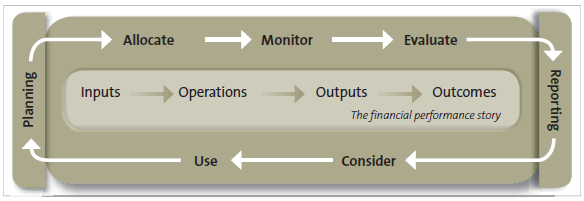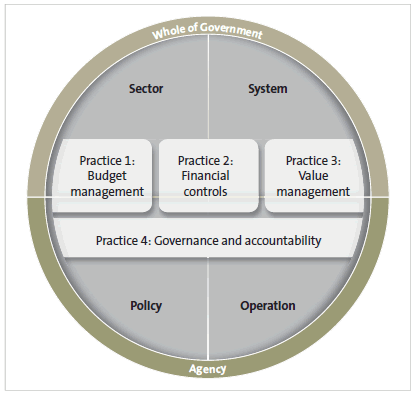Part 1: Managing financial performance
1.1
In this Part, we discuss what financial management is and why it is important, and summarise our main observations about the state of financial management throughout central government.
Introduction
1.2
Internationally, New Zealand's public management system is seen as a world-class model. We are:
- ranked first in Transparency International's latest Corruption Perceptions Index;
- in the 90th percentile for all of the World Bank's Worldwide Governance Indicators;
- placed second in the Stanford Center for International Development's Sovereign Fiscal Responsibility Index; and
- ranked third for institutional strength and 25th overall in the World Economic Forum Competitiveness indicators.
1.3
The latest Kiwis Count Survey, published in 2010, shows that New Zealanders perceive the public service as offering good value for tax dollars spent.
1.4
However, within this system, there have been persistent calls for financial management to move beyond financial control and external accounting, and to provide a more strategic platform. This means working throughout government to align and allocate resources through a cycle where "plans would inform budgets and results would influence plans".2
1.5
In 2008, a Treasury survey highlighted many challenges facing financial management in the public sector. The survey's results showed that the move from "fiscal discipline" to ensuring effective and efficient uses of resources was far from complete. In 2010, Ernst & Young surveyed government finance and concluded that, although progress had been made in embedding financial discipline, there were "consistent and significant gaps in capability".
What is financial management?
1.6
Financial management is a significant part of public sector management. Financial management supports the design and demonstration of an organisation's financial performance story – from financial cost to results or consequences (see Figure 1).
Figure 1
The financial management process

1.7
An effective financial management system provides the right information at the right time to the right people (the supply side) and ensures that the information provided is considered and then used to inform the decisions of those who require it (the demand side).
1.8
Financial management involves establishing what financial resources are available and determining where they are to be directed, how they are supervised, and, ultimately, what value they create – all in a way that is understood and used in managing the financial performance of the organisation. Effective financial management allows stakeholders to understand and control how well the organisation plans for and uses its financial resources to meet the needs of those stakeholders.
1.9
In central government, there are four main financial management functions or "practices" that need to operate within individual public entities (at the policy and operational levels) and throughout the whole of government (see Figure 2).
Figure 2
Financial management in central government

1.10
The four inter-related practices of financial management are:
- budget management – managing the sources of funding and expenditure, and allocating those resources in line with organisational priorities and expected financial performance;
- financial controls – the rules, processes, and procedures that address risks and ensure that financial resources are being recorded and used in the right way, for the right purpose, and at the right time;
- value management – measuring, prioritising, and allocating financial resources based on the expected cost-effectiveness or value for money (VFM) to be derived (sometimes termed "performance management"); and
- governance and accountability – roles, responsibilities, delegations, and structures for making decisions, through which strong financial management can be introduced, practised, reported, and evaluated.
The value of strong financial management
1.11
The value of strong financial management is not based how many plans, budgets, and accounts are produced. As a system, financial management connects the effort of individuals with a public entity's performance, the public entity's performance with overall outcomes, and overall outcomes with the needs of stakeholders.
1.12
A strong and integrated financial management system:
- builds a better "collective intelligence" and, in doing so, provides more accurate, relevant and timely information to decision-makers at all levels;
- motivates better discussion and decision-making by setting the necessary accountabilities and communicating them to internal and external stakeholders;
- supports a more flexible and responsive organisation by promoting continuous improving and an effective workplace where learning takes place; and
- encourages a more co-operative approach to work throughout the organisation by helping to break down barriers to collaborating, such as information hoarding and an inward-looking territoriality.
1.13
Working through many public entities with multiple outcomes and stakeholders, these attributes touch on every aspect and activity of government. They underpin effective and efficient allocating and delivery of public services, promote a collaborative spirit, and encourage more public participation and trust.
1.14
Strong financial management provides the platform for three of the five building blocks (or criteria) that underpin our decentralised model of the public management system. These three are accountability, effective assessment of performance, and adequate information flows the other two being the freedom to manage and clarity of objectives. These building blocks are crucial in motivating initiative, responsibility, and flexibility within public entities while maintaining a wider, more co-ordinated performance perspective throughout sectors, functions, and the whole of government. As the Treasury put it in 1987:
… the absence of any one is likely to allow decision-making inconsistent with a given set of objectives, and if all criteria are met, efficient management will be achieved.3
A summary of our review of financial management practice
1.16
Our review, completed in February 2012, covered four main areas:
- what is considered "best practice" financial management within and throughout government;
- how the financial management system in central government in this country compares with public sectors in other countries and what lessons can be drawn from looking at the private sector;
- the state of our financial management system, using interviews and discussions with officials, chief executives, and chief financial officers (CFOs) throughout government; and
- the roles and responsibilities of working within and maintaining our financial management system.
1.17
Overall, our review shows that our public sector continues to lead the world in the essential areas of budget management, financial control, and external reporting. However, it is also apparent that, as a system, financial management within public entities and throughout central government could be significantly better.
1.18
The most relevant and positive aspects of financial management practice include:
- the frameworks (legislative and regulatory requirements) that govern financial management are largely enough at a public entity level;
- chief executives and CFOs have responded to incentives and understand well what constitutes good performance in budget management, financial control, and external reporting;
- there are pockets of advanced financial management practice throughout government; and
- there are central agency projects such as the introduction of Four-year Budget Plans and the Performance Improvement Framework that seek to improve financial management further.
1.19
The most relevant and challenging aspects of financial management include:
- central agencies' limited emphasis on value management within and throughout government;
- a lack of clarity about governance and responsibility for the financial management system throughout central government;
- accountability structures that are not co-ordinated throughout government and fail to encourage agencies to introduce strong value management practices (through either reward or sanction);
- the continuing narrow role of CFOs, which reflects a perception that financial management is about financial control, managing budgets, and external reporting; and
- various initiatives (for instance, Managing for Outcomes) to address perceived weaknesses in financial management that are not being embedded throughout government.
1.20
These challenges to strong financial management result from a complex interaction of many elements that characterise a decentralised public sector. Many of these challenges have been noted in the reviews of the public sector management system. When taken as a whole, they show a system with a base of infrastructure, processes, and legislative support that needs extra focus and investment.
1.21
It is clear that single initiatives will not resolve these challenges. Progress will be achieved through determined, strong, and sustained leadership from senior officials, public entities, and Ministers. There are important implications for the Treasury, including the need to:
- reconfigure Treasury's role as CFO of government;
- understand what strong financial management entails and how well it is practised within and throughout agencies; and
- use a range of appropriate interventions depending on the risks and opportunities.
1.22
The following Parts of this paper provide further detail about our approach to the review, our observations, and the inferences that we drew.
2: Schick, A. (1996), The Spirit of Reform: Managing the New Zealand State Sector in a Time of Change, State Services Commission, Wellington, page 53.
3: The Treasury (1987), Government Management: Brief to the Incoming Government 1987, Volume I, Wellington.
page top